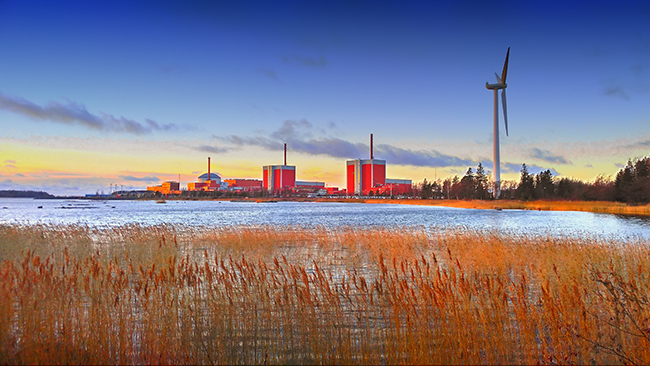At COP in Dubai some countries imagined nuclear power to be part of the solution. Real world experience shows it is too expensive to contribute
Real world nuclear power projects are ridiculously expensive and utterly uncompetitive1. Nevertheless, new nuclear power is marketed again and again as something that will be low cost and able to replace fossil fuels. It is difficult to understand the motives behind these marketing efforts. Even though tax payers or rate payers have had to carry the costs of these projects, very few private individuals have actually earned any money from them, and many private investors have made considerable losses.
Recently, the idea of standardised modular reactors has failed.
The US AP-1000 programme, conceived in the early years of this century with ideas of low costs and short construction times, resulted in four heavily subsidised projects of which two were abandoned after spending almost 10 billion dollars2, while the third, very expensive, reactor is finally in operation and the fourth might produce power in 20243.
The parallel European Pressurised Reactor programme has succeeded in starting six4 and possibly eight5 reactor builds. Three have been completed, of which Taishan 1 and Taishan 2 in China took nine years to build and have now operated with load factors of only 57per cent and 74 per cent respectively.
Olkiluoto 3 in Finland was supposed to start generating electricity in 2009 but did not enter commercial operation until 2023 after almost 18 years of construction.
Flamanville 3 and the Hinkley Point reactors are still under construction and the costs are predicted to be on the order of 2–4 times the original budgets.6
The idea now put forward by the nuclear industry is that smaller reactors will make nuclear power more competitive. There are good reasons to be sceptical. Small reactors may cost less to build, but they also produce fewer kWh each year over which to spread the cost. Experience shows that large reactors produce cheaper electricity than other reactors. That is why modern reactors are the biggest ever.
If you double the size of a reactor vessel it does not double the costs. The same goes for many components.
Similar factors apply to operation. You do not need twice as many people to run a reactor that is twice as large.
Small reactors are likely to produce more radioactive waste per kWh and, according to some experts, more expensive high-level waste7.
One claim that has generated optimism is that the small reactors will be built in such large numbers that industrial learning will bring down costs, just as it has for solar PV panels and lithium batteries. This idea is disputed by Amory Lovins, who explains that 75¬–85 per cent of the costs of a nuclear power plant are common to other thermal power plants where learning has long since passed the early phase in which costs fall fast. Even if learning were to result in reactors being built so efficiently that reactors could deliver steam for free to the turbines, such small reactors would not be able to compete.8
There is yet another argument that seems to have validity. Large reactors create costs as their sudden, long and unpredictable shutdowns disturb the frequency of the alternating current grid and may require large back-up capacity to be available at short notice. With many small reactors these costs would be lower.
In this century only Russia has succeeded in completing a couple of floating small modular reactors, called Akademik Lomonosov, which generate 32 MW each. The original plan was to build seven of them at a cost of 6 billion roubles. But by the time the first two were completed, ten years late, the cost was 36 billion roubles9. They have operated poorly and there are no plans to build any further reactors.
In North America the first Nuscale project that was envisioned to be completed by 2028 has been cancelled due to customers not being able to handle the high electricity costs, despite generous subsidies to both the company and the planned construction.10
A possibly more successful SMR is being built in China. The ACP100 reactor project was started in 2010, design work was completed in 2014, the safety review passed in 2016, construction officially started in 2021 and it is claimed it is even ahead of the construction schedule.11
But even in China, nuclear power is unable to compete. While 1.4 GW of new nuclear capacity was added in 2023, there was 76 GW of new wind power and over 200 GW of new solar capacity.12
So, all over the world nuclear is too expensive to matter economically.
Tomas Kåberger,
is a professor of industrial energy policy at Chalmers University of Technology in Gothenburg, Sweden, and Executive Board Chairman of the Renewable Energy Institute in Tokyo.
1 Words used by Nabou Tanaka, former head of the IEA at a REI event in Tokyo.
2 Summer-2&3
3 Vogtle-3&4
4 Olkiluoto 3, Flamanville 3, Hinkley Point 1, Hinkley Point 2, Taishan 1, Taishan 2
5 If two reactors at Sizewell C are built
6 Cour des Comptes 9 July 2020, https://www.ccomptes.fr/en/publications/epr-sector;
Électricité de France, 23 January 2024, https://www.edf.fr/en/the-edf-group/dedicated-sections/journalists/all-p...
The Chemical Engineer, 26 January 2024, https://www.thechemicalengineer.com/news/hinkley-point-c-could-go-28bn-o...
7 PNAS Vol. 119 | No. 23 May, 2022 https://doi.org/10.1073/pnas.2111833119
8 The Electricity Journal, Volume 35, Issue 4, May 2022, 107122 https://doi.org/10.1016/j.tej.2022.107122
9 World Nuclear Industry Status Report 2022, https://www.worldnuclearreport.org/-World-Nuclear-Industry-Status-Report... , p 52-53
10 Reuters 9 November 2024 https://www.reuters.com/business/energy/nuscale-power-uamps-agree-termin...
11 World Nuclear News 14 July 2024, https://world-nuclear-news.org/Articles/Core-module-completed-for-Chines... ; IAEA, Power Reactor Information System, https://pris.iaea.org/PRIS/CountryStatistics/ReactorDetails.aspx?current...
12 China's National Energy Adminstraion, 26 January 2024, https://www.nea.gov.cn/2024-01/26/c_1310762246.htm




























